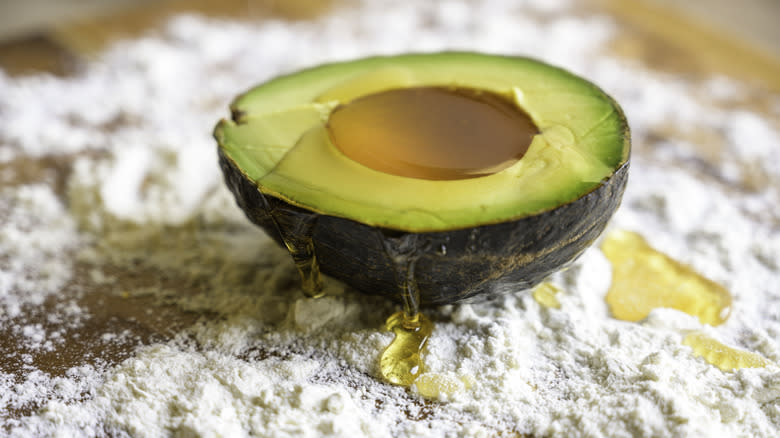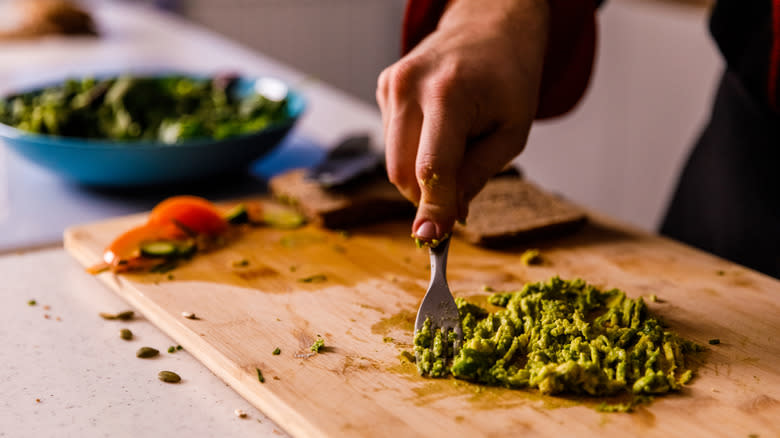Out Of Shortening? Use Avocado Instead

Ingredient substitutions can be a lifesaver. There's nothing worse than being elbow-deep in a cooking or baking project, only to discover that you're missing some key ingredient. If you can perform a simple swap with other items you already have on hand, that's much less annoying than having to head back out to the store.
Ingredient swaps can also be helpful when you want to alter a recipe to suit specific dietary needs. Little exchanges can turn a classic recipe vegan, or otherwise alter its nutritional profile. Even when your kitchen is fully stocked, sometimes it's nice to have these tricks in your back pocket when you want to switch things up for one reason or another. And in case you didn't already know, the incredibly versatile avocado, apart from being chock full of nutritional benefits, is a substitution superhero: In desserts, it can work in place of shortening, as well as eggs or oil.
Since avocado generally works in these applications in a one-to-one ratio, you don't even need to do any mathematical conversions. You can just use as much avocado as you would shortening or oil to easily lighten up all manner of decadent desserts, making them lower in calories without having to cut that sweet, sweet sugar — or worse, use a sugar-free alternative. Blech.
Read more: What These Imitation Foods Are Actually Made Of
Butter, Crisco, And Avocado

If you're an experienced baker, you probably already know that "shortening" refers to fat of any kind that is solid at room temperature, which includes butter, lard, and margarine. But the term is also commonly used as shorthand for vegetable shortening (i.e. Crisco), a shelf-stable product made from a mix of plant-based oils like soybean and palm oil.
The purpose of any kind of shortening, animal- or vegetable-based, is to give baked goods a crumbly or flaky texture, rather than a chewy, bread-like texture, by keeping the gluten from forming long, string-like structures — hence, "shortening." Being that avocado is solid at room temperature, it can perform this function. Just swap it in at a one-to-one ratio; for instance, if a recipe calls for a tablespoon of butter, replace it with a tablespoon of mashed avocado.
If you're watching your calorie intake or simply want a healthier swap, this is a clever way to do it. By volume, avocado has less than ¼ the calories of butter, and less than ⅕ the calories of vegetable shortening. The kind of fat found in avocados is generally considered healthier, too — unsaturated fats, versus the greater proportion of saturated fats found in both butter and vegetable shortening.
The Incredible Edible Avo

But apart from shortening, avocado can perform some other key functions in cooking and baking. If a recipe calls for vegetable oil, for instance, avocado can take its place. Just pulverize the flesh of a ripe avocado until it's as close to liquid as possible (if the fruit is too hard, there are tricks you can try to ripen avocado faster). A food processor may come in handy here.
In some cases, avocado can even replace eggs — particularly in recipes that use egg mostly to provide moisture, like with brownies. Just use about ¼ cup of thoroughly mashed avocado for each egg.
Granted, because avocado has such a different nutritional makeup than the various ingredients you might use it in place of, it will likely behave differently in recipes that you're used to. The sweet, subtle flavor of the avocado may be evident, textures may come out differently than expected, and the fruit's green color may be visible in the final dish. Definitely give any new avocado baking experiments a run-through before debuting them at any parties, so you have a chance to troubleshoot and adjust as needed.
Read the original article on Daily Meal.

